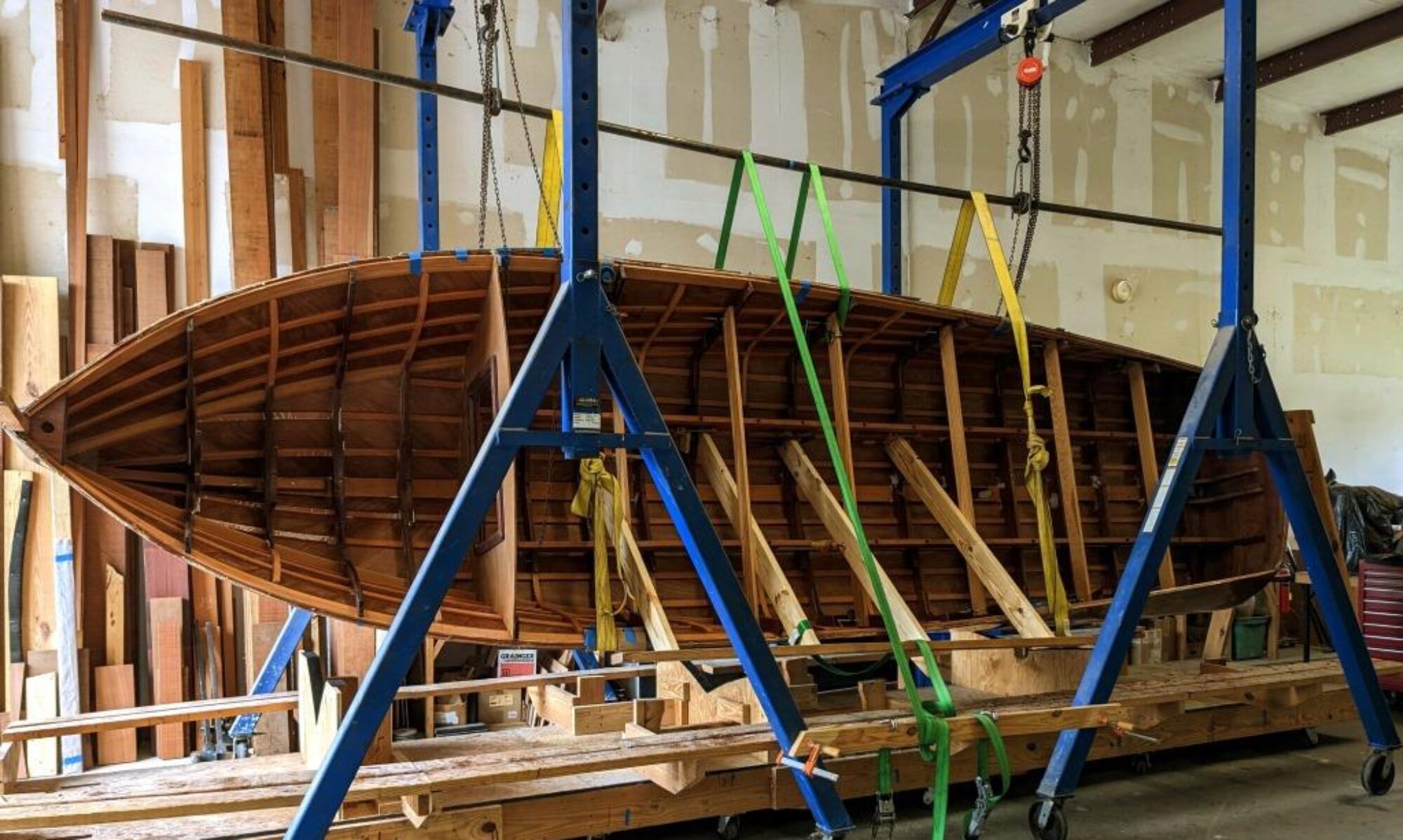
Last month, I described in detail the process of scribing, cutting, and fitting the first strake of final planking on our Palm Beach 22 mahogany runabout. If you missed it, I suggest you go back and take a look. It’s a necessary precursor to the process I’m about to discuss.
Laying up each plank and fitting it is a time consuming, although satisfying process. Refining your skill in creating light-tight seams between planks is a worthwhile pursuit. The better you are at scribing the previous plank edge onto your new blank, the quicker it goes. It’s a time-honored skill among boat builders. But let’s take a look at a more efficient method.
I’m not one to throw around superlatives, but I think The Router Method of fitting planks is pure genius. In essence, you use a router, guided by a shop made fence on its base, to cut an exact match of the previous plank edge on the new plank. Additionally, the router cuts the correct bevel because it rides along the existing plank surface.

First, you’ll need a bit of brass from your local hardware store to make a guide for your router base. As you can see from the picture here, I’ve attached a little brass tang to a shop made router base. The distance from the outside of the brass tang to the outside of the router bit is exactly 3/8″. So clamp your new blank to the boat 1/4″ from the previous plank. Run the guide along the previous plank’s edge, cutting a matching edge into your new blank. Set the depth of the bit so it’s less than the full thickness of your plank. You don’t want to cut into the underlying layers–you just want to establish the edge.
Now, let’s take a breath and walk through the steps to making this router cut successful. Clearly, the edge of your blank needs to be pretty close before you cut it with the router. So clamp it, or a spiling plank to the boat and spile the previous plank edge to your blank. Remove the blank from the boat at cut within 1/8″ of the line with a hand held jigsaw or a bandsaw. Leave the blank about 1″ wider than the final plank will be, and use the 1″ margin at the top to staple it to the boat 1/4″ from the existing plank. Take a look at the first picture and note the staples along the top edge. This keeps a clear path for the router while holding it firmly in place for the cut. I have a scrap of 3/8″ wood I run along the gap to make sure I’m not too close or too wide at any point. Then fire up the router and carefully make your cut.
You should make yourself as comfortable as possible and take your time making this long cut. Invariably because of the parallel angle of the grain, you’ll find the edge will split away in a few places. You can hear the high pitched whine when this happens. If you stop quickly, you can cut away the split edge with a knife or chisel and proceed with no harm done. If you’re not quick enough, you can glue in a dutchman later.
Also, be sure to keep constant downward pressure on the previous plank edge. The router will have a tendency to follow the grain of the new plank, causing it to wander from the line. You can also try climb-cutting certain sections if you just can’t get the router to behave. And if things go completely sideways, you can also start over. That’s one reason you left your blank one inch wide. The other reason is so you won’t have to worry about staple holes from that edge in your new plank.

Once you’ve made a successful cut, take the blank off the boat and finish the edge at the bench with your block plane. Then using your table of girth widths I talked about in the previous post, lay out the top edge of your new plank and cut and finish that edge fair. Remember, this fair edge is what you’ll fit the next plank to.
Dry fit it, cut your butt joints and dress them for a tight fit, leaving the plank about two inches long to overlap the bow or the stern. You can see the screw holes in the bow overlap in the picture above. That extra length gives you a second try if you mess up the butt joint. And it gives you an end you can screw through and then cut away after gluing.
As much as I’d like to, I can’t take credit for this system of fitting planks. I learned about it from Mr. Don Danenberg, who’s book I’ve found to be an invaluable reference for working on wooden runabouts. While he didn’t invent it, he passed it on. And for that we are in his debt.

I feel like I found the end of the rainbow!! I am currently building a Glenn-L 23’ Biscayne. I finished the last vacuum bag on the bottom (4 layers) with 4mm Mahogony plywood last night. I have planed down my mahogony planking for the final layer. I have no idea what to do next…until I stumbled on to your site this morning. I can’t wait to get started on the planking thanks to you!!!!
Hi Dan
I’m so happy to hear that you found it useful. It’s a pretty cool technique isn’t it? I’d love to hear how it’s going for you.